When you imagine a meme, many of you might imagine a funny image with text related to a moment in the universe with some clear format. That’s just an example of a meme that started as an “image macro.” A meme is anything that has spread socially – it could be a sound, idea, image, saying, etc.
A picture is worth a thousand words, but a meme is worth a thousand thoughts
Aditya Shukla, while forwarding memes to different people
Richard Dawkins[1], a pioneering evolutionary biologist and author of the selfish gene[2], coined the term “meme,” which is a social gene. Like genetics, he conceptualized memetics – the spread of ideas from people to people that are not inherited like genes but spread like a virus, socially. So we say, “it went viral; it’s a meme.[3]” While genes typically spread vertically and replicate through inheritance, memes spread and replicate horizontally and vertically. Memes become copies of ideas that spread through people, like culture.
Memes are advanced emotions and outsourced thought patterns + they protect mental health. Using them isn't a waste; it's a reflection of human evolution. Share on XIn biology, a vector is a vehicle that carries a pathogen. Like cough droplets is the vector that carries coronaviruses. Similarly, the internet is the strongest vector for memes, with word-of-mouth and physical location being second and third. And then memes themselves become the vector to carry more information. Considering how memes are naturally shareable, brands piggyback on the meme vector[4] and carry out their marketing plans using viral memes with high success[5].
And how does mitochondria help?
Mitochondria is the powerhouse of the cell.
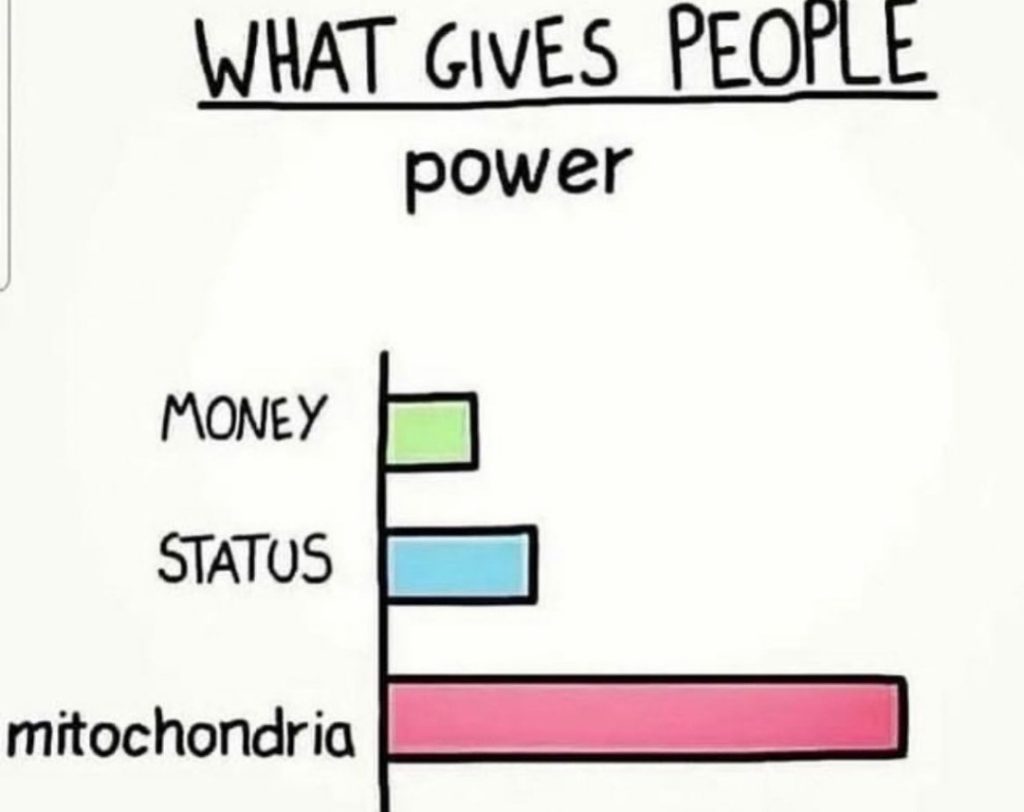

Memes have their own sub-speciE[6]s.
Some are vocalizations like “Yaaaaas queen.” Some are behaviors like “dabbing.” Others are sentences we repeat like “the cake is a lie” The best examples are templated images like the galaxy brain. Some are copypastas – they are copy-pasted walls of text with no context. And some are audio like basically all TikTok songs. They usually spread when there is a triggering event like a post getting a lot of attention, a group of gamers doing it, or an influencer/brand doing something odd. And before they become an established meme, multiple users create hotspots with a chain reaction that keeps seeding the spread.
If you wonder what the pillars of culture are, you might think of language, dialect, religion, location, appearance, shared behavior, traditions, clothing, resources, values, etc. From an abstract sense, culture is a concept formed with specific features, with high importance to labels, shared behavior, and language. In a way, these are social memes. But when technology injected the internet into culture, we got 2 new pillars – internet memes and online behavior. With location synonymous with forums and websites. If one says the world is westernized, we could say the internet culture is 4chan-ized and reddit-ized.
If a picture is worth a thousand words, Memes are worth a thousand emotions, a thousand words, and a thousand pictures, and take no effort. Share on XMemes, behavior, and mental health
Memes protecc, memes attacc, but most importantly, they are a mental health snacc.
Memes create an opportunity for self-reflection (and laughing at/with oneself), which, at the very least[7], helps us to ease symptoms of poor mental health. Research also shows that viewing memes can help people manage burnout and cope with stress[8]. The meme-sharing culture is a collective human identity[9]. Wholesome and AWW-inducing content can make us feel good (and sharp), and sharing these moments improve our psychological state. And they help us bond with others; memes can be a love language too!
If we apply the adage “You are what you eat” to social media, we get the notion that the internet gives us a regurgitated version of what we feed it. Emotional contagion (feeling emotions similar to other peoples’ emotions by witnessing them) can spread via social networks[10]. Emotional contagion theories tell us that seeing negative posts in the newsfeed can make us create negative posts, and seeing positive posts can make us create positive posts.
Clinically depressed people find depressive memes[11] more humorous than neutral memes, and they improve their mood. Researchers believe this effect is due to the humorous take on negative experiences and relatability, which extends to other people who resonate with such memes. The congruence between a depressed person’s mind and the depressive meme’s content can alleviate pain, stabilize mood, and offer an alternative way to manage emotions (healthy alternatives are often difficult for depressed people). There is a good chance that memes can help with depression.
Viewing memes is a valid coping mechanism for anxiety too. Research during COVID[12] shows that anxious people cope with their anxiety using memes, and it actually helps. Anxious people generally found COVID memes funnier and more relatable, and so more shareable. It appears anxiety and meme-coping go hand-in-hand.
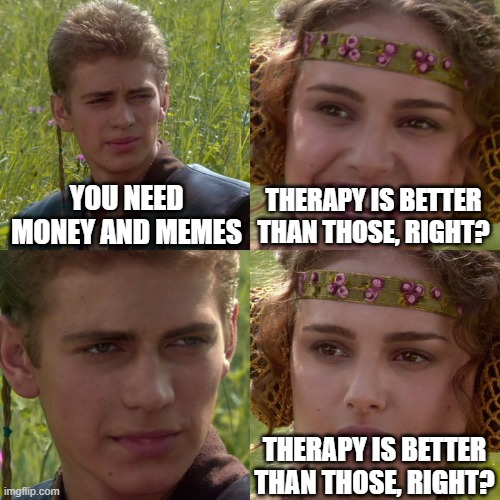
Memes have use in the classroom[13] and business reports too because they are fun, easy, relatable, and attention-grabbing. Studying and creating memes[14] turns out to be a great collaborative learning tool that fosters critical thinking, creativity, and peer relations. Fun and engagement improve cognitive processing at the most fundamental biological level, so the meme culture can improve learning in any context.
Everything about memes sounds good so far (and it’ll sound good in the next sections too). However, like any media or pass time, excess is bad. Too much meme-ing might hint at phone addiction via procrastination, escapism, or constant need for mood repair, and avoiding boredom. And it could turn into an automatic self-sustaining habit. Because each meme is a random positive reward, we try to maximize the total reward by increasing the frequency of reward-seeking behavior[15]. The variety of random rewards – memes – make us scroll through memes, reels, TikTok, and shorts. No variety, no scrolling. However, there is more to this than meets the eye, for real.
Social media is full of negative emotions. Research shows that exposure to negative content that creates negative emotions has a carryforward effect in real life[16] – it makes facial emotional processing more difficult. So it’s likely that you are doomscrolling and fail to recognize emotions in the person sitting next to you. When we ignore others in real life next to each other by going online, we are phubbing them. Phubbing is phone + snubbing, which usually only harms relationships.
Memes are advanced emotions
Memes are social, communicable, and relatable. They are exact feelings evoked from a circumstance. They capture the essence of an experience or a thought and facilitate social behavior. They have emotional properties on many levels. Emotions range from basic to complex, and I propose, that memes are the final level of complexity.
How are memes advanced emotions? First, let’s take a slight detour. Darwin described 6 emotional facial expressions: anger, fear, surprise, disgust, happiness, and sadness. These distinct biological states are related to specific animal behaviors that helped them survive.
- Anger – bargain for better treatment
- Fear – run from danger
- Surprise – learn and attract
- Disgust – avoid dangerous food
- Happiness – repeat a rewarding behavior, attach to people
- Sadness – work to overcome a loss
Later, Paul Ekman redefined these into 6 primary emotions that go deeper than just facial expressions. He later added to the list. These are: Fear, Anger, Joy, Sadness, Disgust, Surprise, Amusement, Contempt, Contentment, Embarrassment, Excitement, Guilt, Pride in achievement, Relief, Satisfaction, Sensory pleasure, and Shame.
Now things get messy. Researchers say emotions and their expressions[17] depend on cultural thought patterns[18] and contexts. So what looks like fear might look like surprise to another. And studies do show that there are similarities. People confuse anger with disgust[19] and fear with surprise[20]. So emotions needed a new classification.
Robert Plutchik then gave us the emotion wheel with 8 emotions: anger, fear, sadness, disgust, surprise, anticipation, trust, and joy, and arranged them in a color wheel. Each of these emotions has variations in intensity. And the uncolored layers become hybrid/complex emotions.
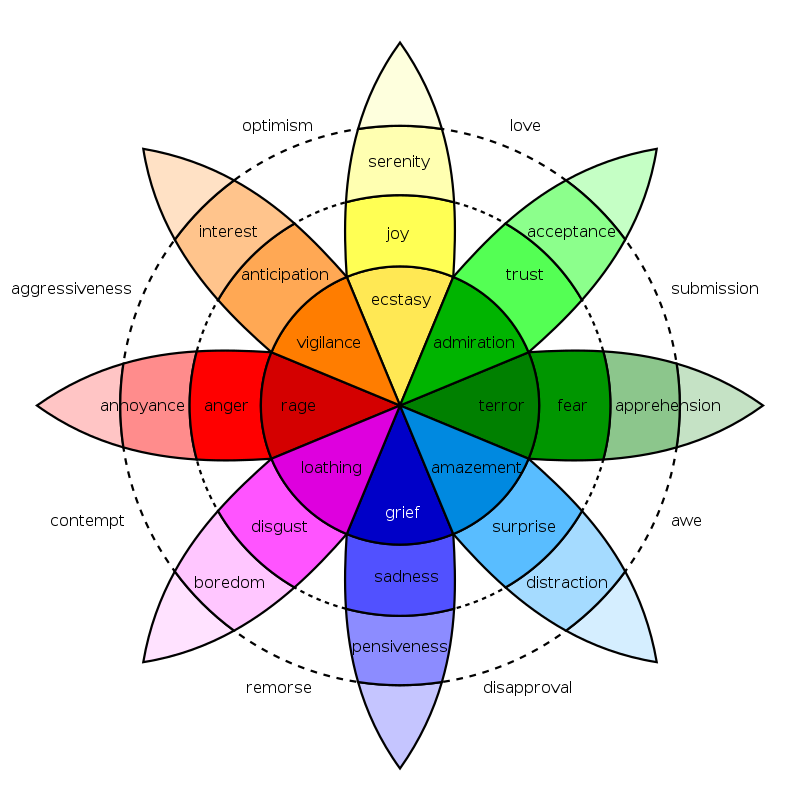
In parallel, James Russel[21] developed the famous circumplex model, which only classified emotions based on 2 properties: arousal (calm vs. stimulated) and valence (pleasure vs. displeasure).
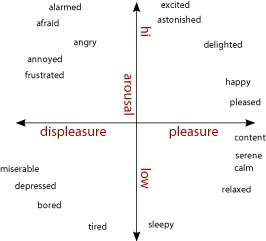
Then came the deeply connected video-watching, react-giving world. Researchers saw that there are nuances in emotions evoked by video content that theories have been missing all this while. They showed emotional videos to people and analyzed the words in their self-reported responses. They clustered the words in a geometric semantic space – arranging words mathematically to see how they group together. They found 27 clusters[22] – effectively, they found 27 emotions. But the boundaries between these emotions were weak.
This isn’t where the story ends. Do you see where I am heading? From 6 to 27. The number of emotions is rising, or is it?
Emotions can be redefined[23] as a mix of 3 basic survival ingredients – reward (happiness), punishment (sadness), and stress (conflict). Various percentages of each create every other emotion. But can they create memes? This is a simple test to see if memes can subsitute emotions. Memes are inherently rewarding, memes can make us feel stupid or bad, and memes can speak a truth that may cause very mild temporary stress.
Why go through this history? To see that emotions are multi-dimensional and are available to us as mere expressions, basic internal states, and hybrid and complex feelings, and they all have their variations.
Now here’s the bonkers bit. Naming a concept[24] – giving it an identity – is enough to give that concept additional meaning[25]. Once you give an idea a “representation,” like a word or a visual, you get a new, real concept[26]. So “arkhdfkghkdfg” is inherently meaningless, but calling it a “thicc typo” makes it a thing. You ignore that identity, and the concept fails to be meaningful[27] (called hypocognition). This brings us to emojis, emoticons, emotes, or smileys, depending on when you got on the internet. 100s of these unique expressions are now uniquely represented with a visual and text.
You can’t just swap one emoji with another and convey the same meaning – each emoji is unique in a context. We now also use emotes as pure expressions, like darwins theory of emotional expressions. Facebook started with the like button and then gave us 6 more reacts. Instagram gave us the heart. Then Whatsapp followed with more reactions to a message; now, all emotes are reactions. On Whatsapp, the stimulus-response game has every emote available as a unique emotional reaction. Every message can have any of the emotes as a react. Giving each emote a visual and context gives it meaning and validity.
It’s still not the end of the story. Reactions can be gifs and memes instead of emotes, and the same rules apply – they are valid emotional expressions because we use them as valid emotions.

You may even reply to someone’s overthinking rant on chat with a trampoline when it annoys you. Meaning jumping to conclusions. Instead of using your own emotion of annoyance, you use a substitute as a way to regulate annoyance, filter yourself and not be mean, and improve their mood – let’s call it “transactive emotional regulation.”

Wilhelm Wundt defined 3 dimensions of emotion: pleasure–displeasure (called valence), arousal–calmness (called arousal), and tension/strain–relaxation (called intensity). Based on that, researchers also looked at music as a way to identify emotions[28] – they found the exact 3 dimensions capture many nuanced musical feelings. Similarly, we can analyze memes.
- Memes have valence: They are funny vs. cringe.
- Memes have arousal: They are meh vs. speak to your soul.
- Memes have intensity: They are uncomfortable/dark/inappropriate or calming/diluting.
When all memes and emojis are available as a unique response to a conversation or situation – the meme becomes the new substituted emotional response. With richer, subtle nuances that add more to the emotion. But is it intuitive? Well, that depends on how much you are exposed to a meme – the more you see it, the more intuitive it becomes.
Memes serve the function of emotions – facilitating specific behavior and social survival, classifying thoughts, bringing a category of thoughts into the mind, helping interpersonal relationships, and relating and empathy. And the kicker, they communicate a nuanced emotion with its context digitally in an effective way, when expression, body language, and words are harder to display with all their subtleties. So memes become advanced emotions, except that they are learned via memetics and not inherited via genetics.
This is not where the story ends, either.
Memes are outsourced thoughts
Outsourcing is the business practice of hiring someone outside the organization to do some work that helps them run their business. And I say, instead of thinking, many of us outsource our thoughts to memes.
If you can think of a meme for a situation, it means there is a ready thought template you acquired through a meme. In the golden days of psychology, these were called schemas[29]—a template of thinking, a representation of a concept, a formulation of logic, an organization of information, etc. They structured thoughts, just like memes structure them. If the meme conveys more meaning than words because of its inherent pattern, you are essentially offloading your thinking process and making the other person understand your thoughts from the meme.

Like this one (the Anakin meme), instead of putting this into words, “Anakin meme stopped trending,” the meme communicates richer information. The meme is outsourced from the shared internet culture, which is our transactive memory – the shared external store of collective memory. Instead of using our brains to process the thought, we use an existing template from the internet culture in the form of a meme to process the thought. Fitting your thoughts into memes or finding the best match is a metacognitive process – thoughts about thoughts.
There is a reason the meme template is called a template – it is abstract. It can be applied to many different thoughts. The same template has different words. That means the thoughts communicated in those words have a common element. That’s the element we learn and use to process new thoughts.
We acquire most thoughts through language and recombining examples into more complex ideas, acquiring them through media or other people, or formulating them using “rules” such as those found in logic or math or faux-rules found in ambiguous frameworks like astrology. Now we have meme templates. So why not use them?
Now, the meme can shape your thoughts. You may start processing the world in meme ideas – the logic or template inherited from it. Like the galaxy brain template is perfect for a hierarchy or escalation with more perspective at each point in the hierarchy. Difficult right? But the meme conveys it better.

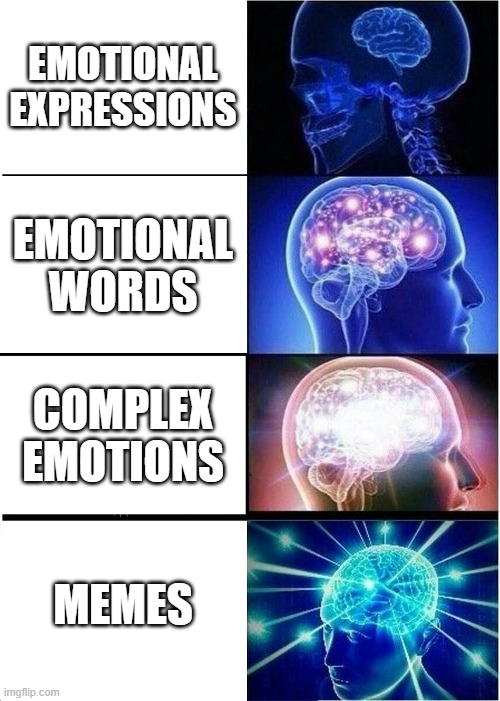
The Drake meme is perfect for portraying narratives and opposing ideas.
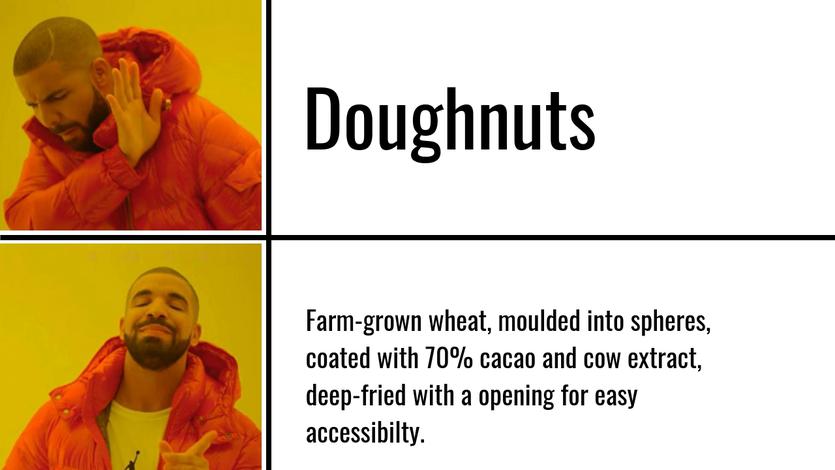
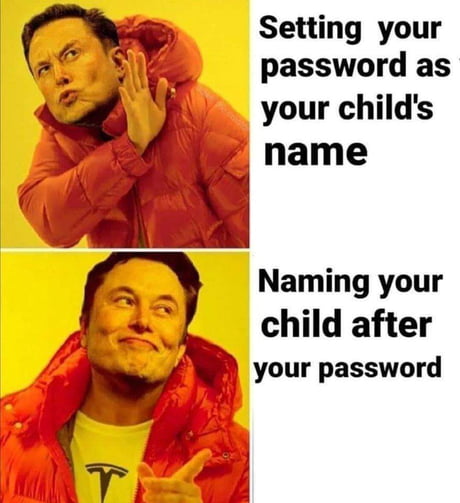
If you go on Instagram and look at the comments, you’ll see recurring patterns like “…. went brrrrrrrr,” “he went 0 to 100,” “I can’t even,” “source: trust me bro,” and “use me as a dislike button.” These aren’t copypastas. These are actual thoughts as a response to content, thoughts that became a meme, which we use because they are easier to communicate, identify, and use.
But some thoughts are empty; they are at a loss… of meaning. Like the loss meme. It’s probably useless to communicate additional ideas using it, but it has meaning – because capturing something as a structure itself makes it meaningful. Patterns are the ingredient of meaning because patterns are the most fundamental property of observing a universe that defines the difference between noise and not noise.
Original comic
Abstract representation

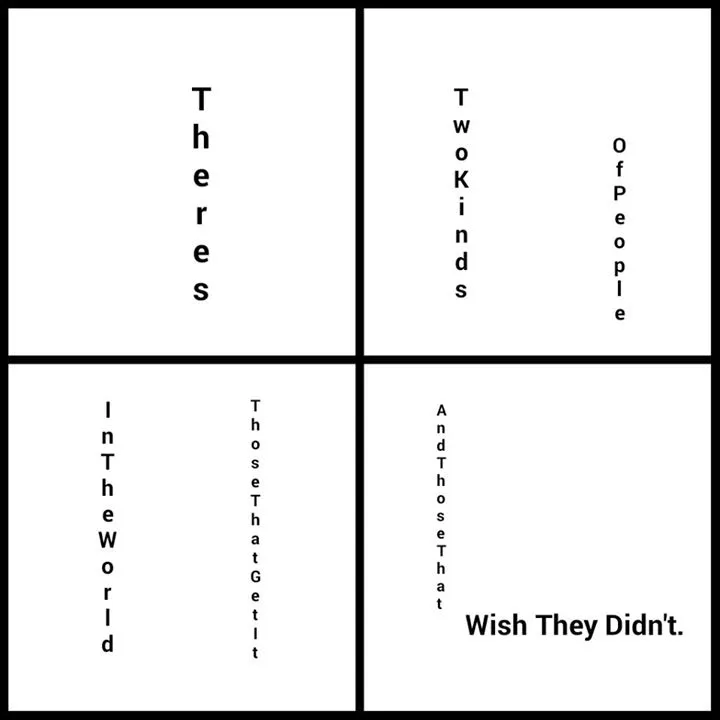
In the more modern sense, popular authors call schemas mental models. These are general methods of reasoning. Sometimes these are simple heuristics like the Pareto-principle (aka the 80/20) rule: 20% of your products will drive 80% of your revenue, or social proof (if others like it, I might like it). Memes are heuristics too. By definition, a heuristic is a method of thinking which is simple, quick, and usually effective in a context. We use heuristics to reduce mental effort and also rely on them when our mind is exhausted. In short, the internet gives us enough reasons to use memes as outsourced thoughts: we are fatigued, we are constantly exposed to them, they are easy, and they say more than just the image or words.
Is this bad? I believe this is mostly a very good thing. Some argue there is no such thing as an original thought. Some say all thoughts are derivates of other thoughts. We also have specific thinking tendencies, so not all of us can think in all possible ways. But I think having so many memes as thought templates gives us new thinking tools, which means more critical thinking and creativity.
Memes are advanced emotions and outsourced thought patterns. When we think or reply in memes, we are using thoughts from our collective external memory with nuanced emotions. Share on XThis isn’t the only way we’ve outsourced thought; we use recommendation engines and trust those everywhere.
Perhaps you think I am rambling on with metaphors and analogies with no real insight, but what if that’s all we as a species can do?
Sources
[2]: https://amzn.to/3elsd4i
[3]: https://www.youtube.com/watch?v=dQw4w9WgXcQ
[4]: https://digitalcommons.georgiasouthern.edu/cgi/viewcontent.cgi?article=1008&context=amtp-proceedings_2021
[5]: https://onlinelibrary.wiley.com/doi/full/10.1002/mar.21702
[6]: https://www.youtube.com/watch?v=dQw4w9WgXcQ
[7]: https://iopscience.iop.org/article/10.1088/1742-6596/1175/1/012250/meta
[8]: https://dc.etsu.edu/honors/499/
[9]: https://firstmonday.org/article/view/5391/4103
[10]: https://www.pnas.org/content/111/24/8788.short
[11]: https://www.nature.com/articles/s41598-020-57953-4
[12]: https://www.nature.com/articles/s41598-021-00857-8
[13]: https://www.researchgate.net/publication/326867169_NeverthelessMemesPersisted_Building_Critical_Memetic_Literacy_in_the_Classroom
[14]: https://scholarsarchive.byu.edu/rlj/vol71/iss2/14/
[15]: https://psycnet.apa.org/doiLanding?doi=10.1037%2F10627-000
[16]: https://www.nature.com/articles/s41598-017-08824-y
[17]: https://www.sciencedirect.com/science/article/abs/pii/S0149763421000774
[18]: https://www.frontiersin.org/articles/10.3389/fpsyg.2020.538793/full
[19]: https://pubmed.ncbi.nlm.nih.gov/22506499/
[20]: https://link.springer.com/article/10.3758/BF03206544
[21]: https://www.ncbi.nlm.nih.gov/pmc/articles/PMC2367156/#
[22]: https://www.pnas.org/doi/10.1073/pnas.1702247114
[23]: https://www.frontiersin.org/articles/10.3389/fpsyg.2019.00781/full#
[24]: https://www.mdpi.com/2079-8954/10/2/41/htm
[25]: https://www.tandfonline.com/doi/full/10.1080/23273798.2021.2001023
[26]: https://psycnet.apa.org/record/1997-06206-009
[27]: https://journals.sagepub.com/doi/abs/10.1037/gpr0000126
[28]: https://www.researchgate.net/publication/222711271_A_comparison_of_the_discrete_and_dimensional_models_of_emotion_in_music
[29]: https://psycnet.apa.org/record/2000-07376-005

Hey! Thank you for reading; hope you enjoyed the article. I run Cognition Today to capture some of the most fascinating mechanisms that guide our lives. My content here is referenced and featured in NY Times, Forbes, CNET, and Entrepreneur, and many other books & research papers.
I’m am a psychology SME consultant in EdTech with a focus on AI cognition and Behavioral Engineering. I’m affiliated to myelin, an EdTech company in India as well.
I’ve studied at NIMHANS Bangalore (positive psychology), Savitribai Phule Pune University (clinical psychology), Fergusson College (BA psych), and affiliated with IIM Ahmedabad (marketing psychology). I’m currently studying Korean at Seoul National University.
I’m based in Pune, India but living in Seoul, S. Korea. Love Sci-fi, horror media; Love rock, metal, synthwave, and K-pop music; can’t whistle; can play 2 guitars at a time.



























